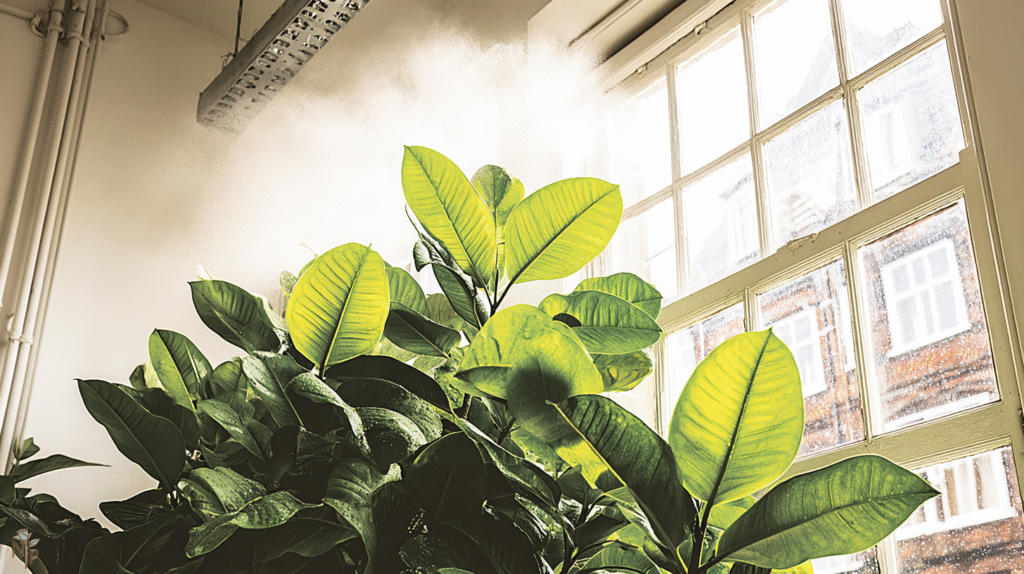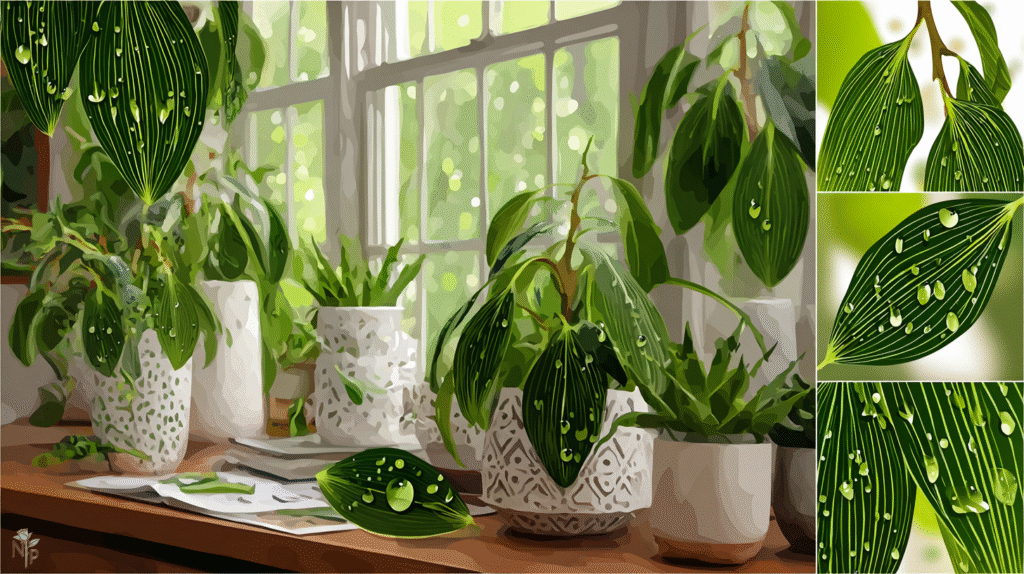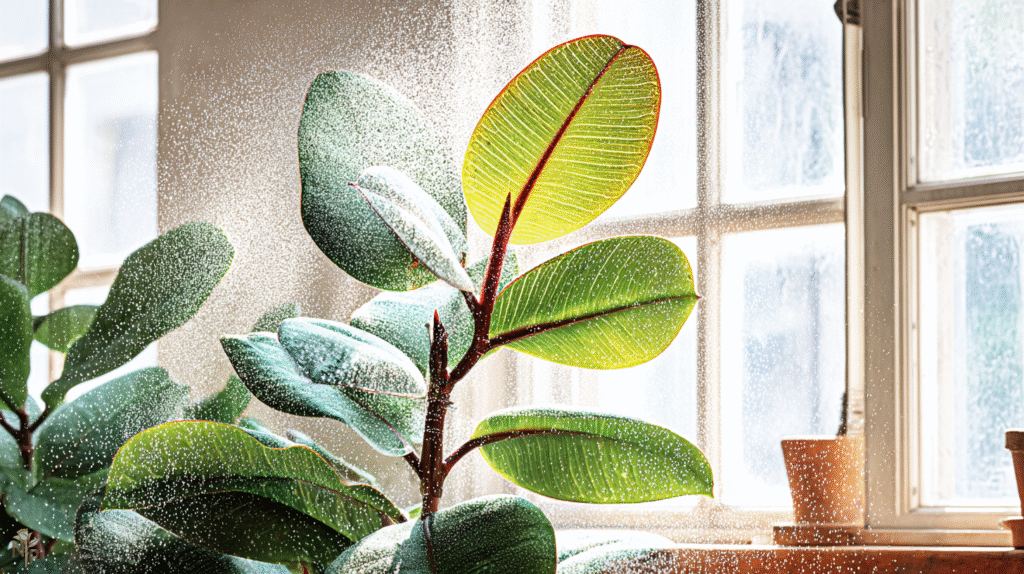The day I brought home my first rubber plant, the nursery guy said, “Water it when the soil’s dry.” Cool. Super helpful. That’s like saying “cook the chicken until it’s done.”
Three months later, I was googling “rubber plant dropping all leaves” while staring at what looked like a very expensive stick in a pot. Turns out “when the soil’s dry” means different things to different people. To me, it meant bone dry, desert dry, forgotten-in-the-back-of-the-cupboard dry. To my rubber plant, it meant “I’m dying please help.”
After killing that first one, plus a second one (overwatered that time – overcorrected hard), I finally figured out rubber plants are like that friend who says they’re “easy-going” but actually has very specific coffee requirements. They want their water just so, and if you get it wrong, they’ll let you know by dramatically dropping every single leaf.
Now I’ve got four rubber plants, including one that’s taller than me and another that survived both a move and my cat knocking it off a shelf. Here’s what actually works, what definitely doesn’t, and why that watering schedule you found on Pinterest is probably killing your plant.
Why Rubber Plants Are Such Drama Queens About Water
Here’s the thing nobody explains: rubber plants are from tropical rainforests where it rains a lot, then doesn’t, then does again. They’re not used to our helpful weekly watering schedule. They want feast or famine, not consistent mediocrity.
In the wild, these things grow into massive trees. In your living room? They’re trying to figure out why it never properly rains but the soil is always kinda damp. It’s confusing for them. Confused plants get sick. Sick plants drop leaves like they’re getting paid for it.
My breakthrough came when I stopped thinking about watering schedules and started thinking about moisture cycles. Sounds fancy, but it just means letting them actually dry out between waterings instead of keeping them in that weird perpetual dampness zone.

The Finger Test Is a Lie (Sort Of)
Every care guide: “Stick your finger in the soil! If the top inch is dry, water!”
Yeah, that killed my first plant.
Here’s why that advice sucks: the top inch dries out in like two days. If I watered every time that happened, my rubber plant would be swimming. The roots, where it actually matters, would never dry out.
What actually works: I use a chopstick. Shove it all the way to the bottom of the pot, leave it for a minute, pull it out. If soil sticks to the bottom half, don’t water. If it comes out clean and dry, water tomorrow. If it’s so dry the chopstick makes a scraping sound going in, water immediately and apologize to your plant.
For my big rubber plant in a 10-inch pot, this means watering every 10-14 days in summer. The small one in the 6-inch pot? Every 7-10 days. Winter? Add another week to both.
But here’s the kicker – my bathroom rubber plant needs water every 5-6 days because the heat from showers dries it out faster. Same plant, different room, totally different schedule. This is why those “water every X days” guides are useless.
The Weight Method That Saved My Sanity
After chopstick-testing got old (approximately two weeks in), I discovered the weight method. Life-changing. Seriously.
Pick up your pot right after watering. Heavy, right? Pick it up every few days after that. You’ll notice it getting lighter. When it feels surprisingly light – like, “is there even soil in here?” light – it’s time to water.
My 6-inch rubber plant goes from feeling like a brick to feeling like a feather. Takes about a week in summer. Once you know the weight difference, you don’t need to test soil anymore. Just lift, assess, water or wait.
Told my mom about this method. She said she’s been doing it for 30 years and thought everyone knew. Thanks for sharing, Mom.
Summer vs Winter: Same Plant, Different Needs
My rubber plant in July is a thirsty beast. Growing new leaves weekly, soil drying fast, basically chugging water. That same plant in January? Might as well be in a coma.
Summer schedule (March-September):
- Big plant: every 10-12 days
- Small plants: every 7-8 days
- Bathroom plant: every 5-6 days
- All get a thorough soaking until water runs out drainage holes
Winter schedule (October-February):
- Big plant: every 18-21 days
- Small plants: every 14 days
- Bathroom plant: every 10 days
- Less water each time – just enough to moisten, not soak
Made the mistake of keeping my summer watering schedule through my first winter. Hello, root rot. Goodbye, beautiful variegated rubber plant I paid too much for.

The Shower Trick That Fixed Everything
Best watering method I’ve found? The shower. Not even kidding.
Once a month (more in summer), I haul all my rubber plants to the shower. Lukewarm water, decent pressure, let it rain on them for about 30 seconds. This:
- Cleans the leaves (they get dusty and can’t breathe)
- Flushes out salt buildup from tap water
- Ensures even watering (no dry pockets)
- Makes them think it’s raining back home
After shower time, I let them drain in the tub for an hour. Never had root rot since starting this. Plus, clean leaves are shiny leaves, and shiny leaves make it look like you know what you’re doing.
Water Quality Actually Matters (Unfortunately)
Used to think people who used filtered water for plants were extra. Then I noticed white crusty buildup on my soil and brown tips on my rubber plant leaves. Turns out my tap water is harder than a calculus exam.
Switched to filtered water (just a basic Brita pitcher) and the brown tips stopped. The white crust disappeared. My plants actually started growing faster. Really annoying that the plant snobs were right about this one.
If you’re fancy, rainwater is apparently the gold standard. I collected some during a storm once. Too much effort. Filtered water works fine.
Pro tip: Let water sit out overnight before using. Room temperature water is less shocking to roots than cold tap water. Learned this after watching my rubber plant literally droop after a cold water watering.
Signs You’re Screwing It Up (And How to Fix It)
Yellow leaves falling off: Usually overwatering. Stop immediately. Let it dry out completely. Like, uncomfortably dry. Then resume watering but less frequently. Lost half my plant learning this lesson.
Brown, crispy leaves: Underwatering or humidity issues. If the soil’s been dry for weeks, it’s water. If you’re watering regularly, get a humidifier or move it away from heating vents.
Leaves dropping but still green: This is the weird one. Usually means inconsistent watering. Like, very wet, then very dry, then very wet again. Pick a moisture level and stick with it.
Black spots on leaves: Fungal infection from water sitting on leaves or overwatering. Cut off affected leaves (I know, it hurts), improve air circulation, and water only the soil, not the leaves.
Entire plant wilting dramatically: Either extremely dry or root rot from overwatering. Check the soil. Dry? Water immediately and it should perk up within hours. Wet? You might need to repot and check for rotten roots. They’ll be black and mushy. Cut them off, repot in fresh soil, pray.
My Current Routine That Actually Works
After three years of rubber plant trials and errors, here’s my exact routine:
Weekly: Lift each pot to check weight. Water the light ones. Takes 30 seconds per plant.
Monthly: Shower party for all rubber plants. They get clean, I get to pretend I’m a responsible plant parent.
Seasonally: Adjust watering frequency. Add a week in winter, subtract a week in summer.
Daily: Nothing. That’s the beauty. Once you nail the watering, rubber plants are genuinely low-maintenance.

The Bottom Line
Rubber plants aren’t hard to water once you stop following generic schedules and start paying attention to YOUR plant in YOUR house. My friend’s rubber plant needs water every week. Mine needs it every two weeks. We live three blocks apart. Different light, different humidity, different pot size, different timeline.
The secret isn’t finding the perfect schedule. It’s learning to read your specific plant. Watch how long it takes to dry out. Lift the pot. Stick a chopstick in it. Give it a monthly shower. Stop overthinking it.
My giant rubber plant that everyone compliments? It gets watered when I remember to check it, which is randomly every 10-15 days. It’s thriving because I let it dry out between waterings instead of keeping it constantly damp like I did with my deceased first two attempts.






